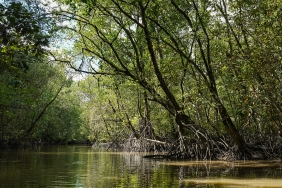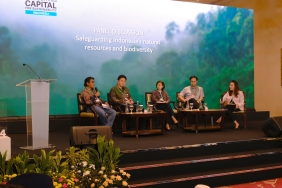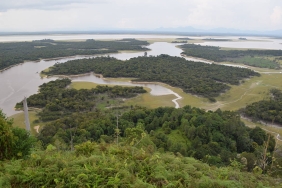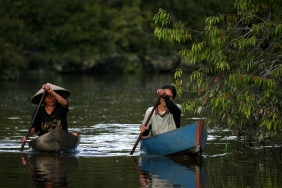THE SWEETHEART OF THE UNCAK KAPUAS
"By: Shella Rimang
Journalist Suara Pemred
This article was written in conjunction with the Lake Sentarum Festival 2018 Pre-event
If you visit Lake Sentarum, it is not valid if you do not bring souvenirs of Lake Sentarum forest honey. This is because Lake Sentarum honey has a specialty compared to honey from other areas in Kalimantan. The area around Lake Sentarum is dominated by peatland. The trees that grow are also unique. The flowers of the trees in the lake area will affect the flavor of the Danau Sentarum forest honey. "The flavor depends on the flowers consumed by the bees. The most typical flowers in Lake Sentarum are putat tree flowers and emasung tree flowers," said the Processing Manager of the Lake Sentarum Periau Association (APDS), A.M. Erwanto, last Wednesday (26/9).
In addition to affecting taste, tree flowers in the Lake Sentarum area also affect the color of honey. For example, if bees consume putat flowers, the color of the honey is slightly orange. While emasung flowers, honey is rather clear. The harvesting system also contributes to the distinctiveness of Lake Sentarum forest honey. The honey harvest system of the people in the lake area is a sustainable harvest system. If the first harvest is in December, the hive can still last until March. This is because the first harvest only takes the head of the hive. "That is the specialty of sustainable honey harvesting. The point is, sustainable harvesting does not kill bee young. We adopted this sustainable harvest from Vietnam," said Erwanto while checking the honey packaging at the APDS secretariat.
Honey bees in the Lake Sentarum area are very sensitive to nature. Bees will come once a year, in the rainy season between September-March. The six months are counted from the process of making nests to harvesting. Therefore, in addition to protecting the forest, honey farmers in the Sentarum area outsmart the bees with artificial branches. According to Erwanto, in the Sentarum area, there are three places for bees to nest, namely tikung (artificial branches), repak (natural branches), and lalau or large trees where bees colonize, which can reach 100 nests.
If it's your first time hearing about this type of beehive, "tikung" will be something that catches your eye. Tikung is not new to farmers in the Sentarum region. The reason is that tikung has been a tradition that dates back to the time of their ancestors. The place to install the artificial branches in the shape of a small canoe is not arbitrary. Tikung is usually installed on shady trees. Because bees do not want to be in the light, small trees cannot be used as a place to install tikung. If you have found a shady tree, the tikung is attached to the tree, with the condition that it must be dark behind the tree. "Bees do not want light. So, only the head of the mat is visible, the other parts are hidden. The bees also maintain the temperature of the hive. The temperature of the nest must be 33 degrees," said Erwanto.
The honey harvested by farmers in the Sentarum area will then be sold at the APDS cooperative located in Semangit Hamlet, Nanga Leboyan Village, Selimbau District, Kapuas Hulu. At APDS, honey that still contains a lot of water is reprocessed.
APDS is a cooperative association that was established in May 2016. APDS oversees 15 periau in the Lake Sentarum area. Please note, periau is a place name (village) based on local wisdom. The 15 periau that are the management area of APDS include: Tikung Periau Tempurau, Tikung Periau Semangit, Tikung Periau Semalah, Tikung Perian Majang, Tikung Periau Pengembung, Tikung Periau Pengembung, Tikung Periau Telatap-Pelaik, Tikung Periau Sumpak, Tikung Periau Meresak, Tikung Periau Melingkung, Tikung Periau Lupak Mawang, Tikung Periau Lubuk Pengail, Tikung Periau Lubuk Kalakati, Tikung Periau Danau Luar, Tikung Periau Belibis Panjang, Tikung Periau Bekuan, and Tikung Periau Suda. In each periau, there is an organizer. "Everything is organized in each periau, before entering this warehouse," said Erwanto.
Honey in the APDS, then sent to Jakarta. Some are also processed at APDS. According to Erwanto, the honey sent to Jakarta amounted to 7 tons, while the stock in APDS was 3 tons. Until now, at least 1 ton of honey has been loaded into 300 gram bottles. The entire amount of honey is stocked for the whole of Indonesia. "This stock is intended so that we maintain the supply of honey, so that the 2018 honey will be harvested in 2019," added Erwanto.
The same thing was also expressed by Ardi Andono, Head of Conservation at the Betung Kerihun and Danau Sentarum Center. According to him, Kapuas Hulu is an organic honey producing area. "We produce at least 20 tons of organic honey per year. And, the most famous is Danau Sentarum honey (referring to APDS). Because the bees eat the trees around the lake," he said.
Besides focusing on processing and selling honey, APDS also focuses on the welfare of farmers. So, the advantage of the association, which has received an organic product certificate from BIOCert and a halal certificate from MUI West Kalimantan, lies in the price. In the past, in the first harvest that took place in December, farmers would scramble to harvest, chasing the highest price. As a result, by the second and third harvests, the honey was already flooded. As a result, the honey was no longer accommodated and the price dropped considerably. Now, with the presence of APDS, in all harvest seasons, prices are standardized.
APDS is loaded with conservation values, so they are very supportive of residents who protect the forest. These honeybees are very sensitive to nature. If the nature is damaged or there is a fire, the following year, the bees will be gone. According to Erwanto, this has happened before, most recently in 2005. Because there was smoke sent from other places, the bees did not come. The honey farmers were distressed. The reason is, bees are a substitute for fish season. During the dry season, it's fish season. If the rainy season and tide means bee and honey season.
The association, which already has more than 300 members, was assisted by the Betung Kerihun and Lake Sentarum Center, and received attention from WWF-Indonesia. This is because the association is based on the traditions of indigenous people, which is to protect the forest. For selected periau included in the APDS management area, in each periau there is a Fire Care Community (MPA) complete with fire extinguishers. Living in a peatland area makes the community very vigilant. "During the dry season, they really protect the forest, for example not throwing cigarette butts carelessly. Because tikung and bees are community assets," explained Erwanto, a man who admitted that he was often stung by bees and never got tired of drinking honey.
Erwanto also said that honey processing in APDS is very helpful for the community. In one of the national park areas in Uncak Kapuas, the community only recognizes two seasons: honey season and fish season. During the honey season, there is no fish season. So, to anticipate land fires, which can cause the loss of honey-producing bees, the community around Lake Sentarum, made an agreement. If someone is caught burning the forest, the perpetrator must pay compensation. "One tikung is compensated for Rp 50,000. For example, in one location there are thousands of tikungs, it will also hurt," Erwanto concluded jokingly. "





